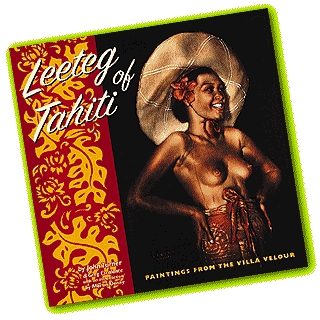
Jim Washburn caressed bare, velvety breasts with hungry eyes. A carefree smile seemed to beckon, "Come away with me to a land where life is easy." Washburn reached out, but he knew he could never possess this sybaritic vision. Still, her image would stay with him forever...
...because Washburn was the proud new owner of Leeteg of Tahiti: Paintings From the Villa Velour (Last Gasp), the new book about the self-styled "American Gauguin," Edgar Leeteg. "His paintings make me more aware of how far humanity has now strayed from a light that any of us actually enjoy," Washburn said. "That, and that naked Polynesians are good."
It was a sentiment widely shared at Seattle's 29th annual Bumbershoot festival of music, art and letters, where an exhibit of 25 Leeteg nudes attracted hundreds of art lovers over Labor Day weekend. One exclaimed, "There musta been 53 great tits in there!"
The display, owned by Danny Eskenazi and David Price, was the largest exhibit ever to spotlight "the father of modern velvet painting," a.k.a. "the bottom feeder of kitsch." During the '40s and '50s, these paintings used to adorn the walls of Hollywood's seminal 7 Seas, and you could find Leeteg's art in other tapa-clothed Polynesian-exotica restaurants like San Francisco's Tonga Room.
Just like the slightly more famous artist, Leeteg fled civilization to immortalize Tahiti's dusky wahines -- although he happened to choose velvet instead of canvas, spawning imitators from Tijuana to Taipei (think Elvis and pool-playing dogs). His stock rose again with the tiki-trend tide of the '90s, but there were other reasons for his popularity. As the painter himself allegedly said, "I have boozed more, fought more, laid more girls and thrown more wild parties than anyone else on the island, but it's all good publicity and gets me talked about plenty, and that's what sells pictures."
The self-described "gin-soaked dopehead" defected to Bora-Boraville in 1933 for a job decorating a movie theater on the island of Moorea. When the theater went bust, he stuck around and returned to his prior vocation of sign painter. On the side, he made portraits of the wizened native men. And, of course, nubile women.
"Leeteg was able to live out the fantasy" of island paradise, says John Turner (co-author, along with Greg Escalante, of Leeteg of Tahiti). The word "fantasy" aptly fits, for while the St. Louis native may have raged until the velvet curtain fell, neither his paintings nor his debauchery are exactly what they may seem to many a wide-eyed admirer.
While he bragged about bedding them, the guy never painted from live models. No, this Rembrandt worked exclusively from photographs -- some he took himself, and some he pinched. Among the latter were slick professional shots produced to entice tourists to paradise and publicity stills from romantic movies made on the islands. "So you can see why Leeteg was accused of perpetuating this islander myth," says Turner.
Indeed, and it wasn't long before the price of a Leeteg soared. Hey, he could paint good, paint fast, and get a message across. After all, he'd studied art a bit and spent years making advertising signs and billboards. Then too, there was "Aloha" Barney Davis, the tattooed sailor who was to Leeteg what Col. Tom Parker was to Elvis.
Leeteg met Davis on a pre-Tahiti trip to Hawaii, where Davis later opened a gallery and sold the velvets. It was Davis, a marketing kahuna, who invented the moniker "American Gauguin," and he used it often to raise his ever-increasing prices. Customers began shelling out $10,000 per Leeteg, a nice chunk of change in the '50s.
Together, the ace promoters also perpetuated Leeteg's raffish image. That image may have had some truth behind it -- alongside all those countless maidens, Leeteg was said to have had two American and two Tahitian wives -- but as he churned out two paintings a week (1,700 in 15 years), he didn't spend all his moolah on grog. Instead, he constructed the palatial Villa Velour, replete with a 10-seat Italian marble outhouse and circular aquarium-bar.
Freeloaders, sex fiends and sots frequented the sybaritic abode, but so did Bertha -- his aged, ailing mother. Leeteg adored Bertha, but Mum became a huge, domineering pain. This may explain why her son, in fine Kerouac/tortured artist style, couldn't leave the drink alone, or cleave to just one woman. Eventually, word got out that Leeteg had picked up the clap. Soon after, in 1953, he died with a proper tragic flair, hurled off the back of a speeding Harley. He was 49.
Leeteg supposedly said he'd rather have his work in a "gin-mill" than entombed by "long-haired bastards" in a repository of "dead art," but he may yet ride into academic history if Eskenazi and Price can raise about half a mil. They want to open a permanent museum to "encourage the appreciation, conservation and preservation" of the velour oeuvre, which apparently dates back to the 14th century. The ideal museum would double as a bar, Eskenazi said, "or a coin-operated peep show in Honolulu."
Bertha might not approve, but Leeteg would be proud.
Rebecca Elliott is a Southern California freelance writer who lives close enough to TJ to decorate with velour.
